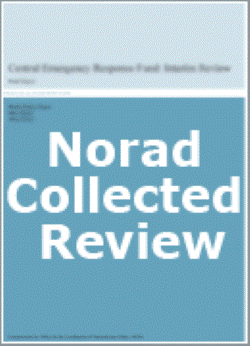Review of the Sino-Norwegian Environmental Cooperation 1996-2005
Om publikasjonen
- Utgitt: juni 2007
- Serie: Norad-innsamlede rapporter
- Type: --
- Utført av: Wu Xiaofu, Central South Forestry University, China and Jens Claussen and Stein Hansen, Nordic Consulting Group
- Bestilt av: The State Environment Protection Administration of China and the Royal Norwegian Embassy, Beijing
- Land: Kina
- Tema: Klima og miljø
- Antall sider: 72
- Serienummer: 14/2007
- ISBN: 978-82-7548-214-1
- ISSN: --

Norway's environment and development cooperation with P.R. China began in 1995-96. It was formalised by a MoU between the National Environment Protection Administration in China (NEPA, now SEPA) and the Norwegian Ministry of Environment in November 1995, followed by a new MOU on technical cooperation in May 2001 between Norad and Ministry of Foreign Trade and Economic Cooperation (MOFTEC). With a contribution of 342 Mill. NOK from the aid budget in the period 1995-2005, to 117 environmental projects, Norway still is small among international contributors to the environmental sector in China.
Interesting Findings
• The important issue for the cooperation with China has not been the financial contribution Norway has made in resolving environmental problems but the access to knowledge and technology from Norway that the arrangement has facilitated. Thus the cooperation should not be considered from the traditional aid management perspective, but from the perspective of fostering regular bilateral cooperation as with any other country.
• In most cases and for most projects the objectives have been successfully achieved. The success can to a large extent be attributed to the fact that the partnership has been between professional parties with highly qualified managers.
• The projects have responded to demands for knowledge-sharing and expertise in resolving critical environmental problems.
• The Norwegian contribution has first and foremost been visible and made an impact through the project outcomes while the general policy dialogue under the framework of the MoUs has had limited impact.
• The projects and partnerships established have been too short term. Building trust and efficient partnerships takes considerable time and patience in China, and to fully reap the benefit requires many years of sustained cooperation beyond the 3-4 years each project is allocated funding.
• Norway has first and foremost managed the cooperation as development assistance to China, as reflected by the fact that the Norwegian aid administration has been given a prominent role in decision making, and the funding has entirely been sourced from the aid budget. In contrast, other countries have predominantly used regular state funding for cross border cooperation (both commercial and institutional cooperation) which applies to bilateral cooperation in general.
• In the case of institutional cooperation projects it has almost entirely been an arrangement made through a joint design process between Chinese and Norwegian partners. The contractual arrangement has been made through a direct negotiation process. None of the projects have been subject to a competitive process among potential partners. This stands in contrast to the approach used by other donor countries that jointly identify projects with the Chinese authorities, and subsequently apply a national tendering process for the selection of the external partner for the Chinese project executing agency.
• While most of the projects under the Norwegian cooperation have been subject to appraisals as input to decision making, they have rarely been subject to a full assessment of cost efficiency, often because the budgets and accounts for the projects have in most cases not been presented in a way enabling assessment of efficiency. This is an important issue in particular for projects not subject to any competitive selection of partners/suppliers. This may serve to explain why the projects sometimes appear to have been designed with a generous volume of Norwegian inputs when comparing total cost with actual outcomes.
• The critical need for establishing cross-sector and province-to-Central Government communication is a lesson learned from the large and complex technology projects at an early stage of the cooperation.
Les nyhetssak på rapporten
